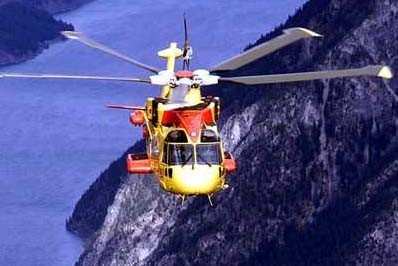A Perilous Rescue Flown With Night Goggles In Low IFR... Yep,
These Guys Are Good
A Canadian Forces search-and-rescue (SAR) helicopter crew was
recognized recently for their heroic efforts in a cliff rescue
earlier this year.

Members of the Canadian Forces 442 Search and Rescue Squadron,
based at CFB Comox, on winning the 2006 Cormorant Trophy for the
skillful cliff rescue of a trapped base jumper near Golden, British
Colombia. The winning crew comprising Captain Hans Kleeman, Captain
Rob Johnson, Master Corporal Brian Schoneberg, Sergeant Conrad
Cowan and Master Corporal Dean Adams were announced as winners of
the Cormorant Trophy, at the annual SAREX event.
The Cormorant Trophy is awarded annually to the crew of the
Canadian Search and Rescue aircraft that carried out the most
significant rescue of the year. Here is the text of the award
citation:
On the night of 20 February 2006, 442 SQN was tasked to proceed
to Golden, BC to assist a base jumper who had become trapped high
above a valley floor on the side of a nearly vertical cliff face.
In short order Captain Kleeman and the crew of Rescue 904 began
preparations to proceed to the stranded jumper with their Cormorant
Helicopter. Inclement weather and a low cloud deck prohibited
Rescue 904 from flying directly to the scene. Instead they had to
pick their way through the rugged mountain passes in near zero
ambient illumination with the onset of nightfall. Navigating with
Night Vision Goggles (NVG) and instruments, the crew arrived in
Revelstoke to refuel and meet with several ground rescue agencies
to plan the next phase of the rescue.
As a result of the jumper's precarious position, perched on a
small ledge 300' below the top of the cliff and 3000' above the
valley floor, it was agreed that the Cormorant was the only asset
with a reasonable chance of success in victim recovery. The
civilian pilot who had released the jumper earlier in the day would
accompany the Cormorant crew to quickly pinpoint the jumper's exact
position to reduce recovery time. With a Buffalo aircraft dropping
a steady stream of flares for illumination, Rescue 904 proceeded to
the area of the stranded jumper. By this time the jumper had been
clinging to a shallow ledge in minus ten-degree temperatures for
eight hours wearing only light clothing; it was clear that he
needed to be evacuated without delay. The jumper was quickly
spotted and a hoist plan was created. After surveying the area,
Captain Kleeman and his crew decided that a blind and extremely
high hoist would be the only way to get a Search and Rescue
Technician (SAR Tech) close to the stranded jumper.
 Hovering 5' from the
cliff wall, the Flight Engineer deployed the SAR Tech down the
hoist cable. The crew lost sight of the SAR Tech after he was 100'
below the aircraft and had to rely on conning commands through
radio communications from the SAR Tech to guide the aircraft
towards the stranded jumper. Finally, at 270', very near the limit
of the Cormorant hoist drum capacity, the SAR Tech radioed that he
had visual contact with the jumper and issued his final conning
commands to make physical contact. After making contact the
aircraft was able to move away from the vertical wall and gain some
separation. After the SAR Tech briefed the jumper on the recovery
procedure he radioed to the crew that he was ready for pickup.
Again the helicopter was forced to hover dangerously close to the
cliff face in order to regain a safe position for the extraction.
After the long hoist back into the helicopter, the jumper was
treated for hypothermia and various injuries and transported to a
nearby hospital.
Hovering 5' from the
cliff wall, the Flight Engineer deployed the SAR Tech down the
hoist cable. The crew lost sight of the SAR Tech after he was 100'
below the aircraft and had to rely on conning commands through
radio communications from the SAR Tech to guide the aircraft
towards the stranded jumper. Finally, at 270', very near the limit
of the Cormorant hoist drum capacity, the SAR Tech radioed that he
had visual contact with the jumper and issued his final conning
commands to make physical contact. After making contact the
aircraft was able to move away from the vertical wall and gain some
separation. After the SAR Tech briefed the jumper on the recovery
procedure he radioed to the crew that he was ready for pickup.
Again the helicopter was forced to hover dangerously close to the
cliff face in order to regain a safe position for the extraction.
After the long hoist back into the helicopter, the jumper was
treated for hypothermia and various injuries and transported to a
nearby hospital.
The initiative and ingenuity that this crew displayed were beyond
reproach. While SAR crews train for many different rescue scenarios
that may challenge their capabilities, this rescue presented
circumstances where only the very best airmanship, courage and crew
cooperation resulted in a successful outcome.
Representatives with AgustaWestland -- manufacturer of the EH101
Cormorant helicopter flown by the Canadian Forces -- said the crew
displayed "remarkable skill and courage" on that night in
February.
"This rescue is a story of exceptional airmanship, in poor
weather, at night with the main blades just five feet from the
cliff edge with the entire crew performing flawlessly to ensure a
successful outcome," said Alan Johnston, Director of Military
Programs at AgustaWestland.
 ANN's Daily Aero-Term (12.08.25): Decision Altitude (DA)
ANN's Daily Aero-Term (12.08.25): Decision Altitude (DA) ANN's Daily Aero-Linx (12.08.25)
ANN's Daily Aero-Linx (12.08.25) NTSB Final Report: Piper PA-31T3
NTSB Final Report: Piper PA-31T3 Aero-News: Quote of the Day (12.08.25)
Aero-News: Quote of the Day (12.08.25) Airborne-Flight Training 12.04.25: Ldg Fee Danger, Av Mental Health, PC-7 MKX
Airborne-Flight Training 12.04.25: Ldg Fee Danger, Av Mental Health, PC-7 MKX




